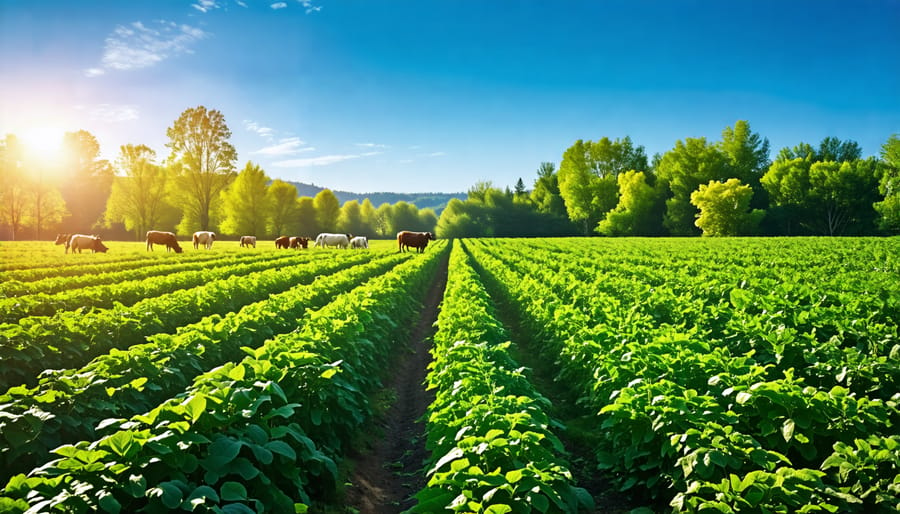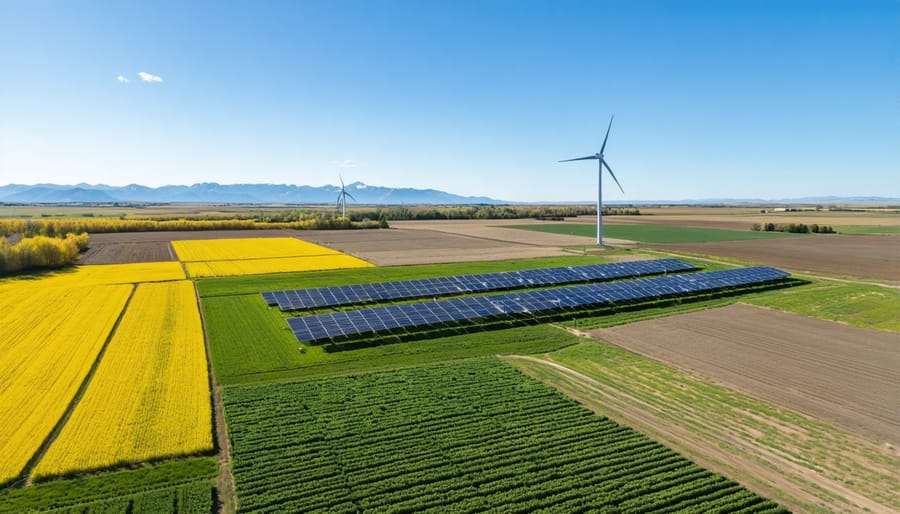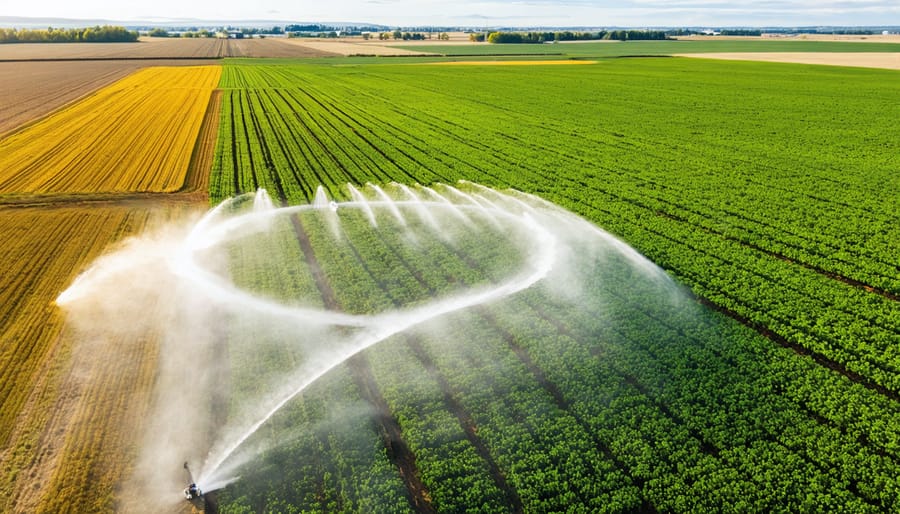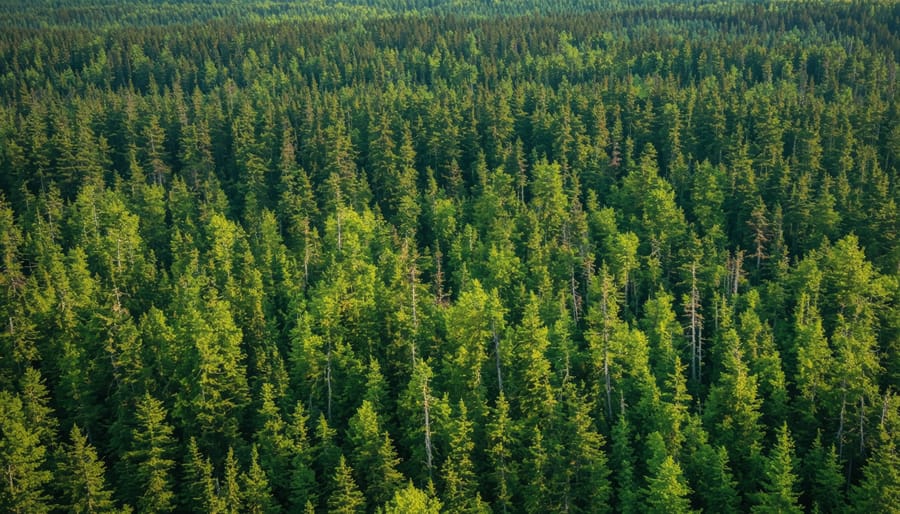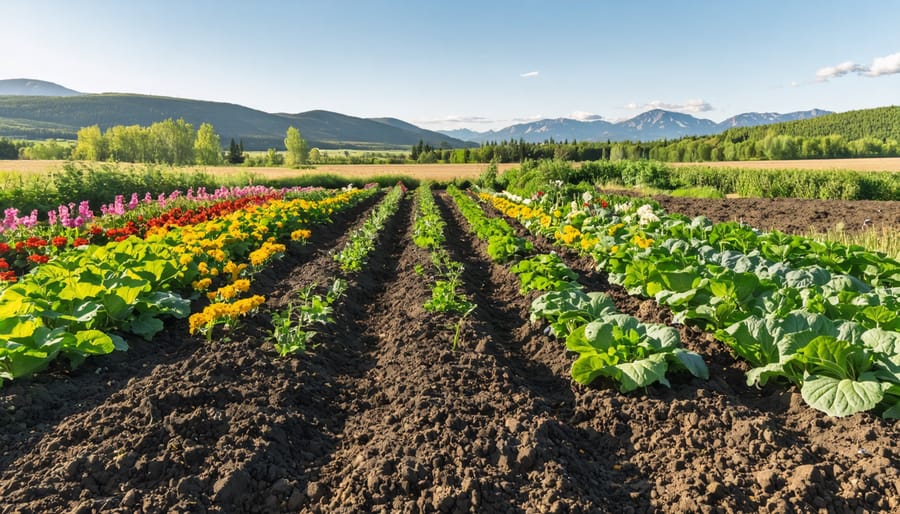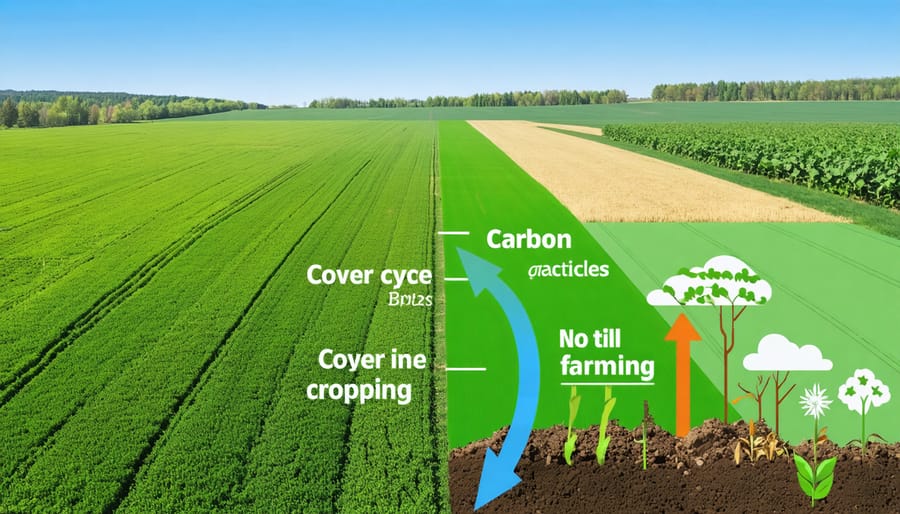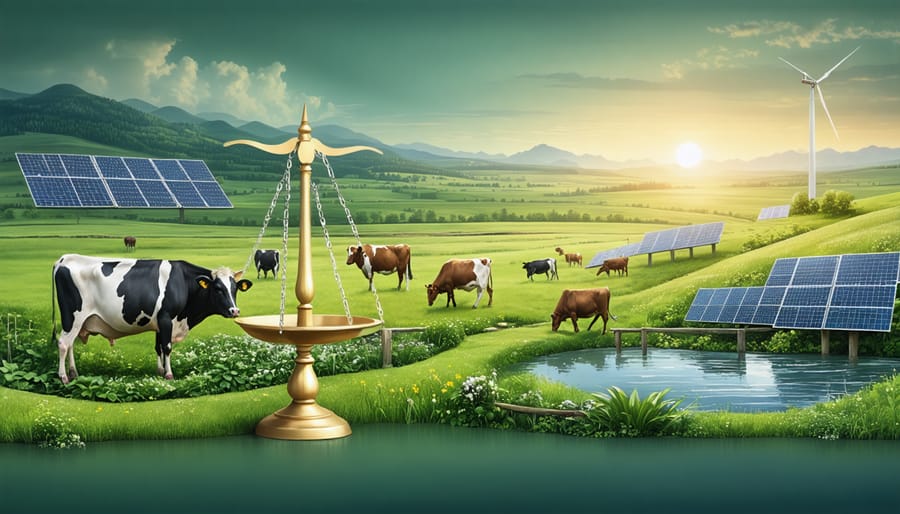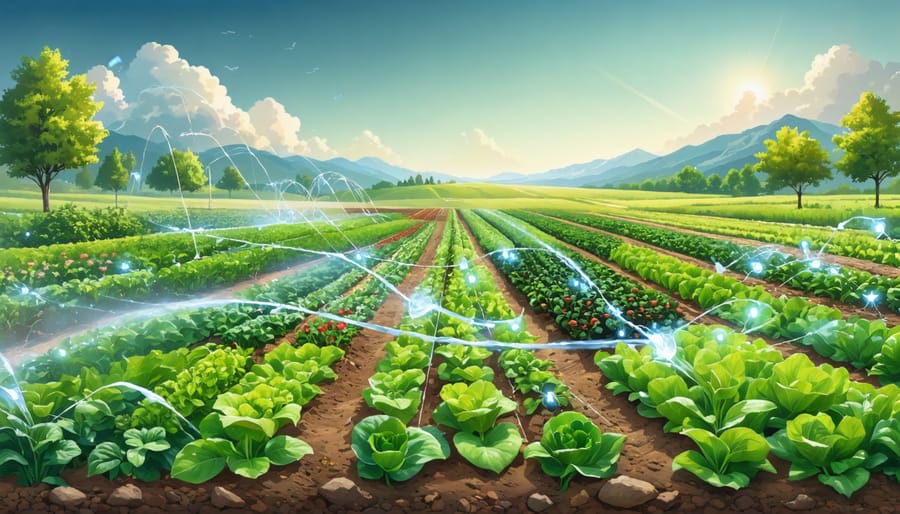Agroforestry, a sustainable farming practice that integrates trees with crops and livestock, offers innovative solutions for Canadian farmers. This ancient land-use system enhances biodiversity, improves soil health, and provides diverse income streams. From silvopasture to alley cropping, agroforestry practices are gaining traction across the country, particularly in Alberta where farmers are embracing these techniques to build resilience in the face of climate change. Through real-life examples and expert insights, this article explores the transformative potential of agroforestry in shaping a more sustainable future for Canadian agriculture.
Silvopasture: Integrating Livestock and Trees
How Silvopasture Works
Silvopasture is a dynamic agroforestry system that integrates trees, forage, and livestock on the same land. In this system, trees are strategically planted in pastures or rangelands, providing shade, shelter, and additional forage for grazing animals. The tree component typically includes species that offer multiple benefits, such as nitrogen-fixing legumes like black locust or honey locust, which improve soil fertility and provide nutritious forage.
The forage component in silvopasture systems can include a variety of grasses and legumes that are well-suited to the local climate and soil conditions. These forages provide a diverse, high-quality diet for livestock while also benefiting from the shelter and microclimate created by the trees.
Livestock, such as cattle, sheep, or goats, are rotated through the silvopasture system in a managed grazing approach. This allows for optimal forage utilization, reduces soil compaction, and helps distribute nutrients from animal manure across the land. The trees offer protection from extreme weather conditions, reducing stress on the animals and improving their overall health and productivity.
Silvopasture systems create a mutually beneficial relationship between the components, with trees benefiting from the nutrients provided by animal manure and the reduced competition from forage plants, while livestock and forage benefit from the shelter and improved soil conditions provided by the trees.
Canadian Silvopasture Success Story
Nestled in the rolling hills of Alberta, Sunset Acres Farm stands as a shining example of successful silvopasture practices in Canada. The farm, owned and operated by the Johnson family for three generations, has seamlessly integrated trees, forage, and livestock to create a thriving ecosystem that benefits both the environment and their bottom line.
“When we first heard about silvopasture, we were intrigued by the potential to enhance our land’s productivity while also improving animal welfare and reducing our environmental impact,” explains Sarah Johnson, the farm’s current manager. “It took some initial planning and investment, but the results have been truly remarkable.”
The Johnsons strategically planted rows of poplar and spruce trees throughout their pastures, providing shade and shelter for their cattle while also diversifying their income through sustainable timber production. The trees help to reduce soil erosion, improve water retention, and create a microclimate that promotes forage growth.
“Not only do our cattle benefit from the shade and protection the trees offer, but we’ve also noticed an improvement in the quality and quantity of our forage,” Sarah shares. “The tree roots help to break up compacted soil, allowing for better nutrient cycling and water infiltration.”
By adopting silvopasture practices, Sunset Acres Farm has demonstrated that agroforestry can be a viable and profitable approach for Canadian farmers looking to enhance their land’s productivity and sustainability.
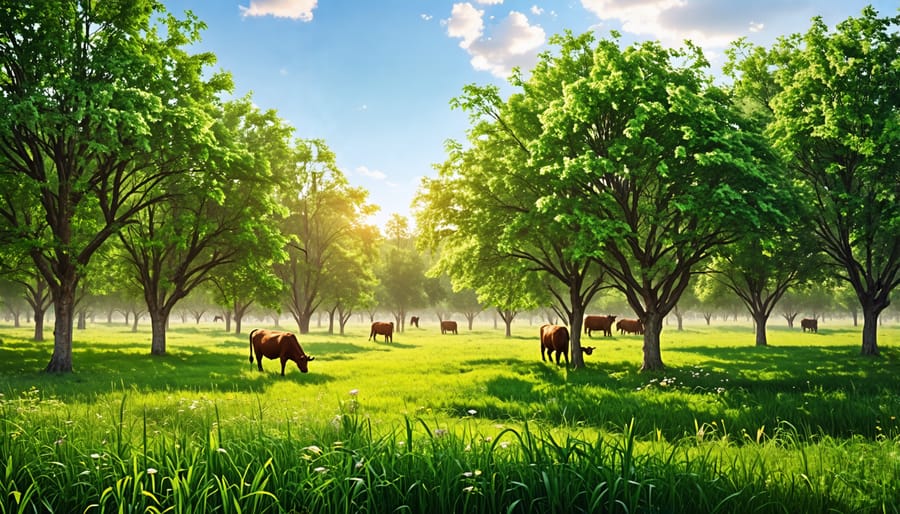
Alley Cropping: Maximizing Land Use Efficiency
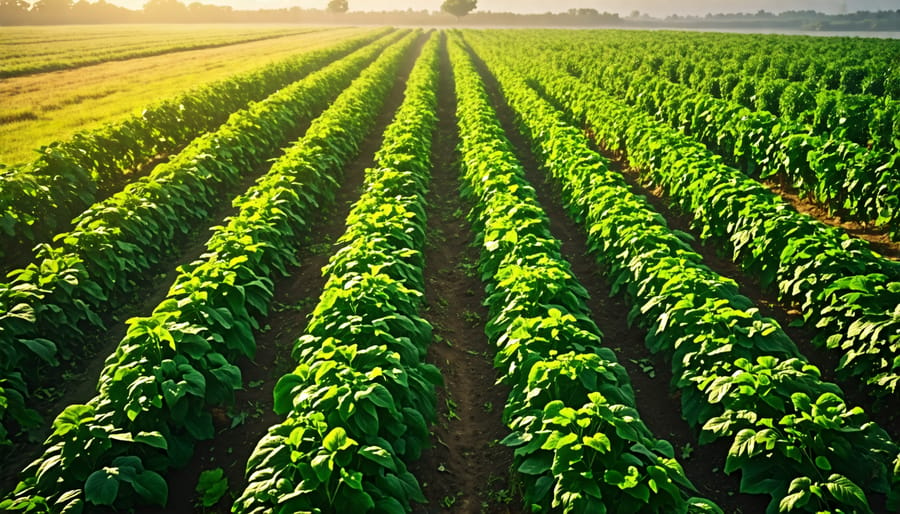
Designing an Alley Cropping System
Designing an effective alley cropping system requires careful planning and consideration of several key factors. First, assess your farm’s climate, soil conditions, and topography to determine suitable tree and crop species. Consider the tree species’ growth habits, root systems, and potential effects on crops. Select crops that are compatible with the chosen trees and can benefit from the microclimate created by the tree rows.
Next, establish the optimal spacing between tree rows and crop alleys based on the selected species, equipment requirements, and desired yield. A common row spacing in Alberta is 12 to 18 meters, allowing for efficient machinery operation. Plan for tree maintenance, such as pruning and thinning, to ensure adequate sunlight reaches the crops and to promote healthy tree growth.
Implement soil conservation practices, like mulching and cover cropping, to improve soil health and reduce erosion. Regularly monitor the system for any signs of nutrient deficiencies, pests, or diseases, and address issues promptly. As the trees mature, adapt management practices to optimize the benefits of the alley cropping system, such as shade regulation and nutrient cycling.
By carefully designing and managing an alley cropping system based on your farm’s unique conditions and goals, you can enhance biodiversity, improve soil health, and increase overall productivity and resilience.
Alberta Farmer’s Alley Cropping Journey
John Smith, a fourth-generation Alberta farmer, embarked on his alley cropping journey in 2015. Faced with soil erosion and declining crop yields, he sought a sustainable solution. After extensive research and consultation with agroforestry experts, John decided to implement alley cropping on his 200-acre farm.
Initially, he encountered challenges in selecting the right tree species and managing competition between trees and crops. However, through trial and error and guidance from mentors, John found success with a combination of hybrid poplar and hazelnut trees, interspersed with wheat and canola crops.
As the trees matured, John noticed improvements in soil health, reduced wind erosion, and increased biodiversity on his farm. The trees also provided additional income through timber and nut harvests. John’s alley cropping system has not only enhanced his farm’s resilience but also caught the attention of fellow farmers in the region.
Today, John is a vocal advocate for alley cropping, sharing his experiences and knowledge with the farming community. He regularly hosts field days and workshops, demonstrating the practical implementation of alley cropping and its long-term benefits. John’s success story serves as an inspiration to other Alberta farmers looking to adopt sustainable agroforestry practices on their land.
Riparian Buffers: Protecting Water Resources
Benefits of Riparian Buffers
Riparian buffers, consisting of trees, shrubs, and grasses planted along waterways, offer numerous benefits for agricultural landscapes. These natural barriers protect water quality by filtering sediments, nutrients, and pollutants from surface runoff before they reach streams, rivers, or lakes. The deep root systems of trees and other vegetation in riparian buffers help stabilize stream banks and prevent soil erosion, reducing the loss of valuable topsoil and minimizing the impact of flooding. Additionally, riparian buffers create diverse habitats for wildlife, including birds, mammals, and beneficial insects, promoting biodiversity on farms. By providing shade and regulating water temperature, these buffers also improve aquatic habitats for fish and other organisms. Implementing riparian buffers not only enhances the environmental sustainability of agricultural practices but also contributes to the overall health and resilience of the surrounding ecosystem.
Canadian Farm’s Riparian Buffer Success
The Blue Valley Farm, nestled in the heart of Alberta’s agricultural landscape, stands as a shining example of the successful implementation of riparian buffers. This family-owned operation, led by the visionary farmer John Thompson, has embraced the power of agroforestry to protect and enhance the natural ecosystems that border their fields.
By planting a diverse mix of native trees, shrubs, and grasses along the banks of the stream that runs through their property, the Thompsons have created a thriving riparian buffer that spans over 2 kilometers. This carefully designed buffer strip not only provides critical habitat for wildlife but also acts as a natural filter, trapping sediment and nutrients that might otherwise pollute the waterway.
The positive environmental outcomes of Blue Valley Farm’s riparian buffer are evident. Water quality tests have shown a significant reduction in nitrate and phosphate levels downstream, while the increased shade from the trees has helped maintain a stable water temperature, benefiting aquatic life. The buffer has also reduced soil erosion, protecting valuable topsoil and minimizing the need for costly remediation efforts.
John Thompson’s dedication to sustainable agriculture has inspired other farmers in the region to follow suit, fostering a growing community of land stewards committed to preserving Alberta’s natural heritage for generations to come.
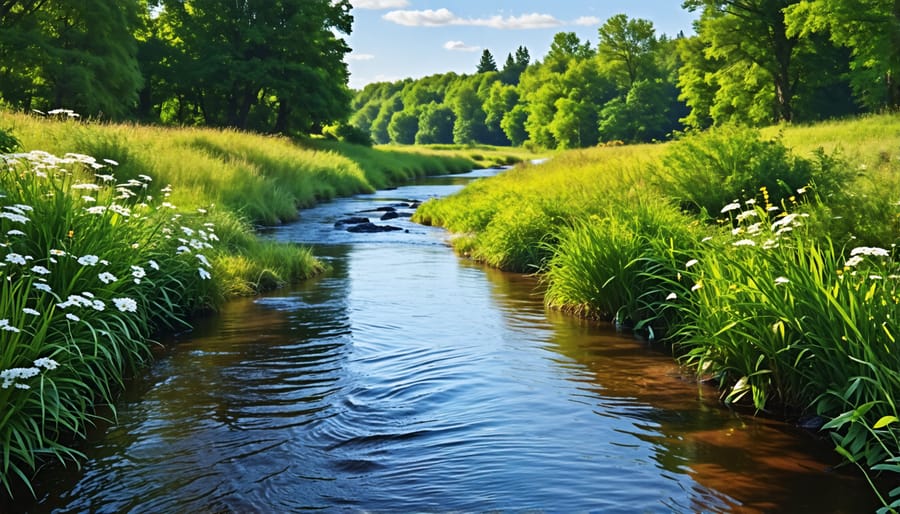
Windbreaks: Enhancing Farm Resilience
Windbreak Design and Benefits
Windbreaks, strategically designed and planted rows of trees or shrubs, offer numerous benefits for Canadian farmers. An effective windbreak design typically involves multiple rows of trees and shrubs of varying heights, planted perpendicular to the prevailing wind direction. This layout creates a wind-resistant barrier that reduces soil erosion, protects crops from wind damage, and helps maintain soil moisture. Well-designed windbreaks can significantly enhance farm productivity by creating a more favorable microclimate for crop growth. They can also provide habitat for beneficial insects and wildlife, contributing to a more balanced and sustainable ecosystem. Additionally, windbreaks can serve as living snow fences, helping to distribute snow evenly across fields and reducing the need for snow removal. By incorporating diverse tree and shrub species, farmers can also benefit from additional income streams, such as harvesting fruits, nuts, or wood products. Properly planned and maintained windbreaks are a valuable tool for Canadian farmers looking to improve their land’s resilience and productivity while promoting sustainable agriculture practices.
Canadian Farmer’s Windbreak Wisdom
John Deere, a fourth-generation farmer from Strathmore, Alberta, has been successfully integrating windbreaks into his farm landscape for over two decades. “Windbreaks have been a game-changer for our farm,” he shares. “Not only do they protect our crops and soil from wind erosion, but they also provide habitat for beneficial insects and wildlife.”
Deere explains that he started by planting a mix of native trees and shrubs, such as white spruce, green ash, and caragana, along the edges of his fields. “It’s important to choose species that are well-adapted to your local climate and soil conditions,” he advises. “Working with a local agroforestry specialist can help you create a customized plan for your farm.”
Over the years, Deere has seen numerous benefits from his windbreaks, including increased crop yields, reduced soil moisture loss, and improved biodiversity on his farm. “The windbreaks have created a more resilient and sustainable farm ecosystem,” he notes. “Plus, they add a beautiful aesthetic to the landscape.”
Deere encourages other farmers to consider integrating windbreaks into their own operations. “It takes some planning and effort upfront, but the long-term benefits are well worth it,” he says. “Windbreaks are a smart investment in the future of your farm and the environment.”
Conclusion
In conclusion, agroforestry practices offer a multitude of benefits for Canadian farmers, from enhancing soil health and biodiversity to diversifying income streams and improving climate resilience. The examples discussed in this article showcase the potential of agroforestry to transform agricultural landscapes and contribute to a more sustainable future for farming communities across the country.
As we’ve seen, farmers in Alberta and beyond are already implementing innovative agroforestry systems, such as alley cropping, silvopasture, and forest farming, with impressive results. By integrating trees and shrubs into their operations, they are not only improving the ecological health of their land but also reaping economic rewards through the production of diverse crops, livestock, and value-added products.
We encourage readers to explore how agroforestry could be applied on their own farms, drawing inspiration from the case studies and expert insights shared in this article. Whether you start small with a windbreak or dive into a more complex system like forest farming, every step towards integrating trees into your agricultural landscape can make a difference.
By embracing agroforestry, Canadian farmers have the opportunity to build resilient, productive, and profitable operations while contributing to the health and well-being of their communities and the planet as a whole. Let’s work together to create a thriving, tree-filled future for agriculture in Canada.

